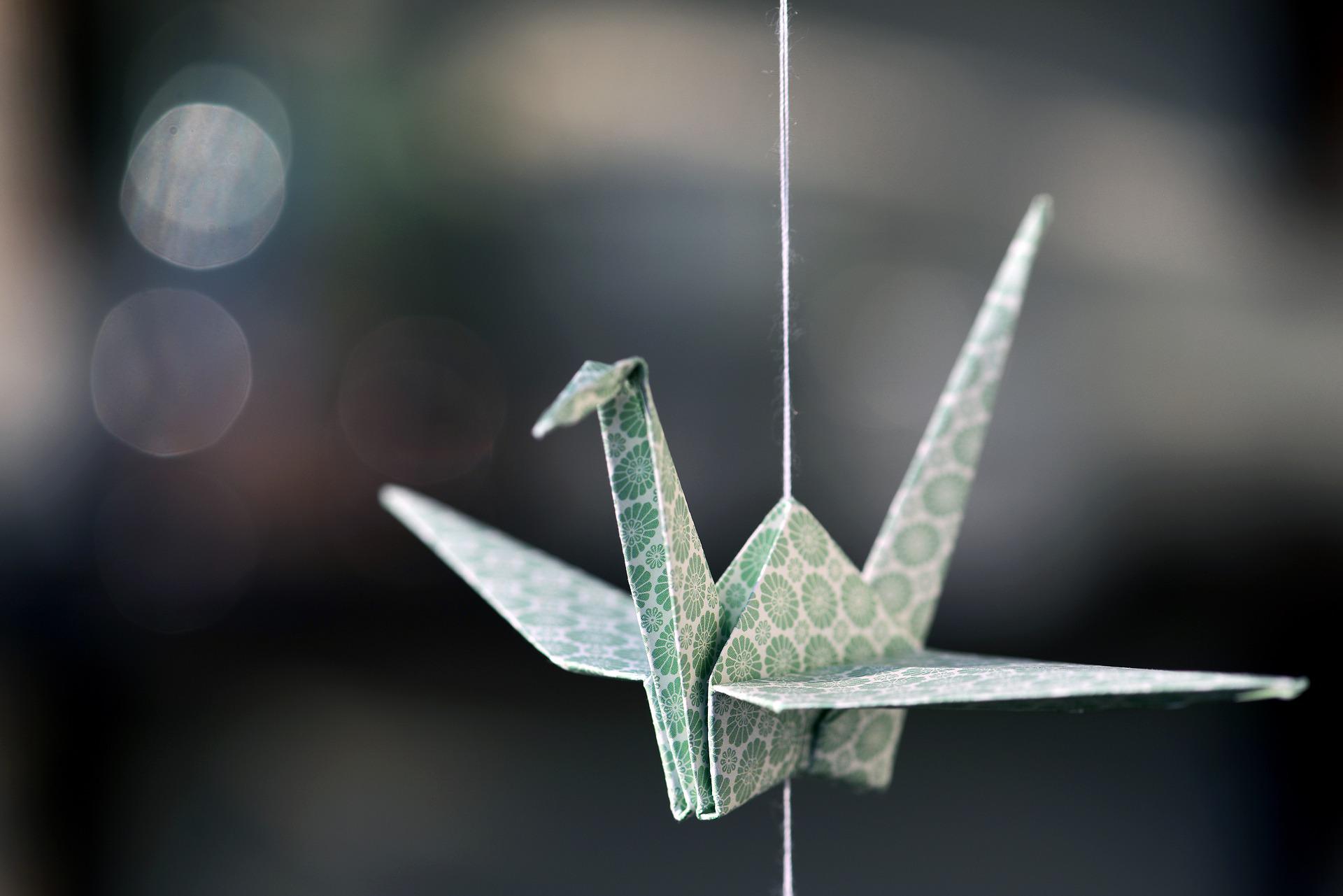Origami and individualized mindfulness
Aug 27, 2022 — Jacob van Haaften
A number of years ago I worked as a youth program leader. I love working with children. I find their honesty refreshing and their energy, well, energizing. One day, one of the children in the program asked me to teach him how to make an origami crane. I didn’t even know how to make a paper airplane that flew straight! But this child was normally very shy and didn’t participate very much in the activities, so I dedicated my night to learning how to fold a crane.
A couple of days went by, and I found myself surrounded by a massive collection of folded paper birds. I had found a video online that walked you through each step of folding the crane, and, after a few attempts, I had a slightly bent and crumpled bird in front of me. I started the folding adventure just after dinner that night, around 6 pm. When I first looked at the clock, it was nearly 11 pm! The time had (pun intended) “flown” by! I realized that I hadn’t checked my phone the entire time and that I felt relaxed and comfortable.
Fast forward a few years, and I learned the term “mindfulness.” At first, I was turned off by the concept. It sounded like a waste of time. “I already know how to breathe,” I thought, “who needs to clear their mind? Minds are for thinking!”
As you are someone who has visited this blog, you have likely started your mindfulness journey or are shopping around for the right app or service. Maybe you’ve tried mindfulness practice or meditation before. Maybe you’re an expert. But if you’re anything like me, you’re on a lifelong journey of getting to know yourself better.
When I first started to practice mindfulness “officially,” I was very frustrated with my mind’s inability to focus. I often found myself experiencing intrusive thoughts. And even though the mindfulness leader said that it was okay to have these thoughts, I was still upset. After a few weeks of practice, I was ready to give up.
I was still working as a program leader, so my days were filled with loud noises and energetic youngsters. I loved that job, but as anyone who has worked with kids will tell you, it is a lot of work! I came home one night after chatting with the same child who had requested the origami crane. They had not stopped making cranes, to the point that their mom was running out of places to display them at home.
That day, the child wanted to learn a new origami pattern, but I still only knew how to make the crane. So, like the first time, I went home and tried to learn a new pattern. That night I learned how to make a lotus flower. For those who don’t know, making an origami lotus flower involves several repetitive steps. As I was working on flower number seven, my phone dinged; I had a notification from my mindfulness app to start my daily practice. But there was no way that I was going to be distracted from my origami adventures. I had almost made a perfect lotus, and there was no stopping until I had it memorized for the program.
After my phone dinged a second time, I decided to take my revenge on the app. It was interrupting me, so I decided to disrespect it by putting it on in the background while I folded. I had to hear its notifications, so I decided to play the meditation and ignore it––this was my masterplan for revenge against a phone app.
I started the meditation and continued to fold. A few minutes into the practice, I had memorized the lotus pattern, and to my great annoyance, I began to listen to the words of the meditation. I continued to fold the repetitive pattern, and the mindfulness leader asked me to focus on my breathing. Usually when this part of the practice came I would hyperfocus on my breath and ask myself “was that breath too deep or too shallow? I think I’m breathing more through my left nostril––is that bad?”. But this time, as I continued to fold the paper, I acknowledged my breaths for what they were. I noticed that it felt good to take deep breaths, and my hands continued to work the paper. This practice was different. By the time the practice finished, I had also finished the lotus.
I reflected back to the first time I had tried origami. I recalled how quickly the time had gone, how focused I had been. I immediately googled the definition of mindfulness. Medito shares that “There is a simple way to understand mindfulness: it’s being fully aware of whatever is going on in your current experience. You’re not thinking about the past or worrying about the future. You are completely in the present moment.” (Medito Foundation, n.d.) Was I practicing mindfulness in my origami?
I was aware of my breathing, but more than that, I was aware of the paper between my fingers, the delicate pressure I used to fold, my bodily experiences.
Mindful origami
I now know that origami is a mindfulness practice for me. Here are a few mindful concepts that I have learned from origami.
- Finding the beauty: Paper can seem boring, but it can also be beautiful and exciting. It is a wonderfully satisfying experience to see your origami piece start to look like your goal, and acknowledging the feelings from this can help to center you.
- Taking it one step at a time: In origami, it’s important to focus on your current step. You need to complete each step before starting the next one. This helps me to focus on what I’m doing in the moment.
- Knowing yourself and your patience: Origami can be very frustrating. As with any activity, things don’t always turn out perfectly. This is okay, and it can even help you to learn more about yourself and your triggers and tolerances. When I start to get frustrated and can’t concentrate on the step in front of me, I know that it is time to take a break. This can also help me to recognize when I need to rest in other aspects of my life.
While origami isn’t for everyone, if you are interested in trying, I suggest that you read this article and explore different models online. You don’t need fancy tools or expensive paper, and there are numerous free resources available.
Personal journeys
My mindful experiences with origami don’t mean that origami will provide mindful experiences for everyone, however. Because mindfulness is about ourselves, the experience of mindful practice is subjective. It is phenomenological. Phenomenology is both a philosophy and an approach. According to the Stanford Encyclopedia of Philosophy it is “the study of ‘phenomena’: appearances of things, or things as they appear in our experience, or the ways we experience things, thus the meanings things have in our experience,” and it “studies conscious experience as experienced from the subjective or first person point of view” (Smith, 2013). When we think phenomenologically, we acknowledge that every person, every experience, and every emotion is truly unique to a person and their current reality. In other words, our life stories are unique.
Any activity in which we bring our full awareness to our current experience can be considered a mindfulness practice. We just need to find one that suits us. Origami is great for me, but it might not be great for you. Other activities might work for you and not for me. One of my supervisors in university once shared their mindfulness journey with me. He was a chemist and a brilliant scientist, but he had not spent much of his time reflecting on himself and what made him human. He attended a workshop where the participants were invited to take part in several different interactive sessions. There were yoga, beading, sewing, and breathing activities. At the end of the session, the facilitators asked the participants how they felt. The overwhelming response was that they felt relaxed and refreshed. The facilitators then shared that the participants had been engaged in mindfulness practice. My supervisor shared that he was confused by this. He had heard of mindfulness, but he had assumed that it meant sitting in a dark room and trying to empty your mind for hours at a time. This changed his perspective, and he became an avid mindfulness practitioner and advocate.
After this conversation with my supervisor, I thought about my own mindfulness journey. I too had found mindfulness through what I considered to be an unorthodox path. I am not an expert in mindfulness or psychology, but what I can share with you is that mindfulness is about you and you alone. If you find something that works for you, then you’re already doing something right. Maybe you enjoy spending time in nature, or maybe spirituality is a significant part of your mindfulness, or maybe you haven’t yet found your mindful rhythm. No matter where you are on your journey, remember that mindfulness is about you, enjoy that and have fun with it.
References
Medito Foundation. (n.d.). What is mindfulness? Medito Foundation. Retrieved August 7, 2022, from https://meditofoundation.org/resources/what-is-mindfulness
Russel. (2016). Origami and mindfulness. Origami Expressions. https://origamiexpressions.com/origami-and-mindfulness
Smith, D. W. (2013). Phenomenology (Stanford Encyclopedia of Philosophy). Stanford.edu. https://plato.stanford.edu/entries/phenomenology/
van Haaften, J. (2022). The nature of mindfulness. Medito Foundation. https://meditofoundation.org/blog/the-nature-of-mindfulness
Yorke, S. (2022). Discussing Mystical, Spiritual & Psychedelic Meditative Experiences With Dr. Daniel Ingram. Medito Foundation. https://meditofoundation.org/blog/discussing-mystical-spiritual-psychedelic-meditative-experiences-with-dr-daniel-ingram
